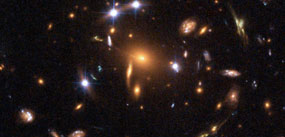Syllabus
Printable syllabus [pdf]
AST 309R
"Galaxies, Quasars, and the Universe"
Fall 2012
Professor Gregory A. Shields
TTh 2:00-3:15 pm in Welch 3.502
Unique No. 47765
Course Description
How did the universe begin? How did the fiery gases of the Big Bang collect into “island universes” like our own Milky Way, even as the universe as a whole was expanding into the frigid emptiness of today? What processes led to the formation of stars, planets, and life? Where do we go from here?
This course presents modern observations and theories of the structure and evolution of the universe. Topics include the evidence for the Big Bang, the formation of galaxies, and the nature of quasars. We trace the evolution of the universe from the first moment through the creation of the primeval fireball radiation and the birth and evolution of galaxies. We examine the rich variety of observations of quasars, the evidence for giant black holes, the accelerating universe, dark matter, and dark energy.
Mathematics will include high school algebra but no calculus.
Prerequisite. AST 301, 302, or 303, or an equivalent descriptive introduction to astronomy of one semester or more.
Instructor. Professor Raphael Flauger. Office: RLM 9.301. Phone: . E-mail: shieldsga@mail.utexas.edu. Office Hours (subject to change):
Web page: https://www.as.utexas.edu/~shields/shields.html
Teaching Assistant: TBA
Help sessions: TBA
Grading: The course grade will be based on three one-hour exams in class, and homework. (No final exam.) Exams will be closed book and will involve both multiple choice and essay questions. Exams will cover lectures, assigned reading, and homework. Make-up tests will not be given except for a compelling reason presented in advance or in case of illness. Exam weights and tentative dates are:
|
First exam |
20% |
TBA |
|
|
25% |
TBA |
|
Third exam |
30% |
TBA |
Homework will count 25%, based on grading of selected problems from homework sets.
Help sessions. Help sessions will be scheduled for help with the homework and class material.
Textbook: There is no required textbook. The instructor’s informal textbook will be made available in PDF format at no cost. Course content will center on the lectures and book, supplemented with materials available on the World Wide Web.
Drop Dates. September 14 is the last day to drop a class for a possible refund. November 6 is the last day to change to or from the credit/no credit basis. After November 6, you may drop the course or withdraw from the University only for urgent and substantiated, nonacademic reasons. Please consult the University's published calendar (http://registrar.utexas.edu) to verify these dates and for further information.
Star Parties. Every Wednesday evening, if the weather is clear, there will be astronomical viewing with the 16-inch telescope on the roof of RLM Hall. These sessions will start about 7 p.m. during standard time and 8 p.m. when daylight saving time is in effect. There is also a 9-inch telescope on Painter Hall that is open to UT students on Friday evenings and to the general public on Saturday evenings. For observing hours, see the Department of Astronomy public outreach Web page at http://outreach.as.utexas.edu/public. You can use the 9-inch yourself if you are checked out on it. McDonald Observatory in west Texas has star parties and public nights (see http://mcdonaldobservatory.org/visitors/programs; phone 471-5285).
Astronomy Department Policies. For information on Department policies and courses, see https://www.as.utexas.edu/astronomy/education/courses.html, which includes links to the Memo to Undergraduate Astronomy Students and the Course Catalog headnotes.
About the Instructor: Professor Shields was born in Los Angeles, California and grew up in Nebraska and Kansas. He earned a B.S. in Physics from Stanford University in 1968 and a Ph.D. in Astronomy at Caltech in 1973. Following a postdoctoral fellowship at Harvard, he joined the UT faculty in 1974. He now holds the title of The Jane and Roland Blumberg Centennial Professor in Astronomy, and served as Chairman of the Department of Astronomy from 1990 to 1994. He teaches both graduate and undergraduate courses at UT. His research interests include studies of nebulae, quasars and black holes, and he has published numerous research papers and popular articles.
Suggested reading:
The Big Bang, by Joseph Silk (2001), W. H. Freeman and Co., 3rd ed. A survey of cosmological ideas from the ancients to the latest scientific theories. Emphasizes observations and theories of the early universe and galaxy formation.
The Cosmic Perspective, by Jeffrey Bennett et al. (6th ed., Addison Wesley). An introductory astronomy text; later sections deal with galaxies and the universe. A shorter version called The Cosmic Perspective: Stars, Galaxies, & Cosmology is similar but omits the solar system. Any recent edition of these or similar introductory astronomy books should be good for review.
"The University of Texas at Austin provides upon request appropriate academic accommodations for qualified students with disabilities. For more information, contact the Office of the Dean of Students at 471-6259, 471-6441 TTY."
